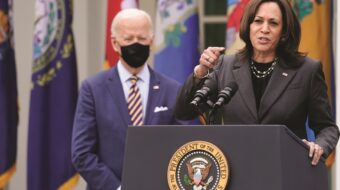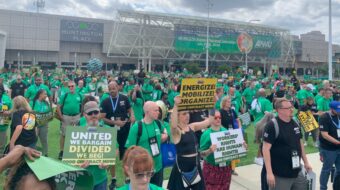Mexican labor authorities seized on technicalities to order an end to the strike at the country’s largest copper mine in Cananea, Sonora, on Friday. The Mexican press reports that over 700 heavily armed agents of the Sonora state police arrived in Cananea just hours before the decision was announced, and agents of the Federal Preventative Police were sent to this tiny mountain town as well. Strikers report that the streets were filled with rocks and teargas, and 20 miners have been injured – some seriously – in the ensuing conflict. The union says that five strikers are missing.
The action by the government seeks to end the longest-running defiance of government labor policy in Mexico in decades. The mine belongs to one of the largest mining corporations in the world, Grupo Mexico, which is owned by the wealthy family of German Larrea.
On June 29 of last year, the union at Cananea, Section 65 of the Mexican Union of Mine, Metal and Allied Workers, went on strike over extreme health and safety dangers. Since the beginning of the strike, both the company and the labor board in the state of Sonora, which is controlled by Mexico’s old ruling party, the Institutional Revolutionary Party, as well as the company itself, have tried to declare the strike illegal. The union won an injunction, called an “amparo,” from the Mexican Federal Court on December 13, protecting the strike’s legal status.
Under Mexican law, if the strike is legal, the company may not make any effort to operate the mine or make reprisals against the strikers. If the strike is declared illegal, however, the company can begin operations, and fire any striker who refuses to return to work. Miners fear the presence of heavily armed police is intended to protect a company effort to reopen the mine with strikebreakers, or to frighten strikers themselves into returning.
Smashing the strike in Cananea would have economic and political repercussions, not just in Mexico, but in the United States as well. In two previous strikes, at Cananea and its sister mine in Nacozari, in 1998 and 2005, respectively, over 2,000 miners lost their jobs. Most of them, unable to find other work in the tiny mining communities of northern Sonora, crossed the border into the US as undocumented workers in order to survive.
Grupo Mexico has extensive ties with US corporations. It became the owner of two mines and a smelter in Arizona when it bought the bankrupt American Smelting and Refining Company. The union in those mines, the United Steel Workers of America, has actively supported the striking miners in Cananea. Grupo Mexico’s chief financial officer, J. Eduardo Gonzalez, is a former executive of Kimberley Clark de Mexico, the Mexican subsidiary of the US-based paper corporation Kimberley Clark. That company was founded by the family of Wisconsin Congressman James Sensenbrenner, one of the most vociferous opponents of Mexican immigration to the US. Grupo Mexico’s board of directors also shares a member with the board of the US Carlyle Group (which included former President George H. W. Bush).
Grupo Mexico has been at war with the Mexican miners union for over three years. In 2001, Napoleon Gomez Urrutia was elected as the union’s president. He soon became a high-profile opponent of the Mexican government’s conservative economic policy, successfully fighting its effort to weaken labor law and privatize its pension system. Taking advantage of high world copper prices, Gomez negotiated wage increases much higher than the limits the government sought to impose in its effort to attract foreign investment.
On February 19, 2005, 65 miners died in a huge explosion in the Pasta de Conchos coal mine in the northern state of Coahuila. That mine belonged to Grupo Mexico. The union found that workers on the second shift had complained of high concentrations of explosive methane gas in the shafts before the accident. “They told us that welding was still going on, even after the failure of some electrical equipment,” Gomez charged.
Two days after the explosion, Gomez Urrutia accused the Secretary of Labor and Grupo Mexico of “industrial homicide.” Then-President Vicente Fox filed corruption charges against Gomez less than a week later, and Labor Secretary Francisco Xavier Salazar Sáenz appointed Elias Morales to replace him as union president. Morales had been expelled from the union for his close relationship with the company. Gomez fled to Canada to avoid arrest, where the United Steel Workers gave him sanctuary, and where he remains. While in exile, he was twice reelected president of the union, although Grupo Mexico and the government refused to recognize him.
A July 2006 report by the National Human Rights Commission found that the local office of the federal labor ministry responsible for inspecting Pasta de Conchos had “clear knowledge” before the accident of the conditions that set off the explosion. In 2004, labor safety inspectors had found 48 health and safety violations in the mine, including oil and gas leaks, missing safety devices, and broken lighting. Although Grupo Mexico was given an order to fix the illegal conditions, no compliance inspection was carried out until February 7, 12 days before the explosion.
The Cananea strikers say conditions in their mine also threaten their lives and health. Rock dust in the enclosed part of the huge complex, called the concentrator, is so deep that it rises up over workers’ boot tops. “When the mine is running,” says Victoriano Carrillo, a member of the mine’s health and safety commission, “you can’t even see more than a few feet in front of you.”
Mine dust is more than just uncomfortable or inconvenient: it’s deadly. Superfine particles lodge in the lungs, and miners who breathe rock dust year after year suffer a variety of lung diseases, including silicosis. Cananea miners charge that the vacuum apparatus that is supposed to suck dust from the complex has been disconnected and inoperable for a decade. “We know what’s safe and what’s not,” one miner charged, “but they never want us to spend time fixing problems – just get the production out. If we tried to stop the line for safety problems, we would lose our jobs.”
In October, a binational delegation of health and safety experts from Mexico and the US visited the Cananea mine and performed preliminary health screenings on 68 of the 1,300 strikers. “We documented appalling working conditions in the open-pit mine and processing plants where workers are exposed to high levels of airborne silica, which can cause fatal diseases like silicosis and lung cancer,” stated Garrett Brown, a California health and safety inspector and director of the Maquiladora Health and Safety Network. “Ironically, the Mexican Labor Department’s own safety inspectors found the same hazards in an April 2007 inspection of the facility and issued a laundry list of 72 ‘corrective actions,’ including fixing the cranes’ brakes and re-assembling the dust collectors. None of the mandated corrections, many of which had also been identified in previous inspections, had been completed by the time the workers went on strike over health and safety issues on July 29.”
According to Grupo Mexico, the strikers are supporters of Gomez Urrutia, and are striking to pressure the company and government into reinstating him. But breaking the strike in Cananea would allow the company and government to install a company union at the mine, as they have at many others over the last two years. In November 2006, the federal Mexican labor board, under the control of the conservative government of the National Action Party and President Felipe Calderon, gave legal status to a new miners union, the National Union of Workers in the Exploration, Exploitation and Benefit of Mines. Grupo Mexico was a large contributor to Calderon’s 2006 presidential campaign.
The new union is headed by Francisco Gamez, a former contractor for Grupo Mexico who once worked at Cananea. The federal labor board set up elections to allow it to take over representation rights in eight mines. The Center for Labor Action and Reflection (CEREAL), a human rights organization, charges that the election process was manipulated to get rid of the old miners union. Fifteen workers were fired before a vote at a San Luis Potosi mine, CEREAL says. In Nueva Rosita, Coahuila, miners on the first and second shifts were locked inside the coal mine for a day before balloting began, while 300 federal, state and municipal police surrounded the mine entrance.
At Nacozari, where 1,500 workers were fired for striking in 2006, over 900 were denied voting rights. Workers brought in to replace the fired miners were told they would be fired themselves, evicted from company housing, and sent back to southern Mexico if the company union didn’t win the vote there. Rita Marcela Robles Benitez, an analyst with CEREAL, charges that Grupo Mexico “changed the working hours from 8 to 12 per day, which has resulted in more accidents because of the lack of safety protection and training.” The new union approved the change.
The government and Grupo Mexico have been prevented from holding a similar election at Cananea because of the strike. If the strike is smashed, however, authorities will probably hold one there to eliminate the miners union, and allow Grupo Mexico to deal with the company union instead.
When the miners union lost its strike in Cananea in 1998, in which it tried to stop the elimination of hundreds of jobs, blacklisted strikers poured into Arizona in the months that followed. If the current strike is put down, the union broken and its leaders and activists terminated, they too will likely find themselves in Phoenix, Tucson or Los Angeles, hungry and desperate for work.
truthout.org











Comments